Table of Contents
It is important for us to understand the term Digital marketing to understand the digital marketing metrics for measuring success and their relevance.
Any form of marketing of any product or service where advertising is delivered through electronic or digital channels such as social media, email, web applications, search engines, mobiles, websites etc.is called digital marketing.
Important Digital Marketing Training Metrics for Measuring Success
Digital Marketing Metrics are statistics used by marketing teams to assess and track the success of a promotional campaign. Digital marketing companies use a variety of platforms and devices to promote their product or service, and tracking the results can be time-consuming and difficult.
There are a variety of digital marketing training metrics that are used to assess the popularity and outcome of a digital marketing campaign, including the number of sites visited, engagement level, ROI, cost per sale, and so on…
What Are Digital Marketing Metrics and KPIs?

It is very crucial for marketing teams to keep track of the performance of their marketing campaigns.
In fact, there are hundreds of statistics and analytical combinations that could help you analyze your marketing strategies and customer behaviour.
Not all would be relevant to your marketing plan.
It is important for marketing teams to determine their targets and goals.
in order to to promote their services and products.
despite tracking the results can often be time-consuming and difficult at the same time.
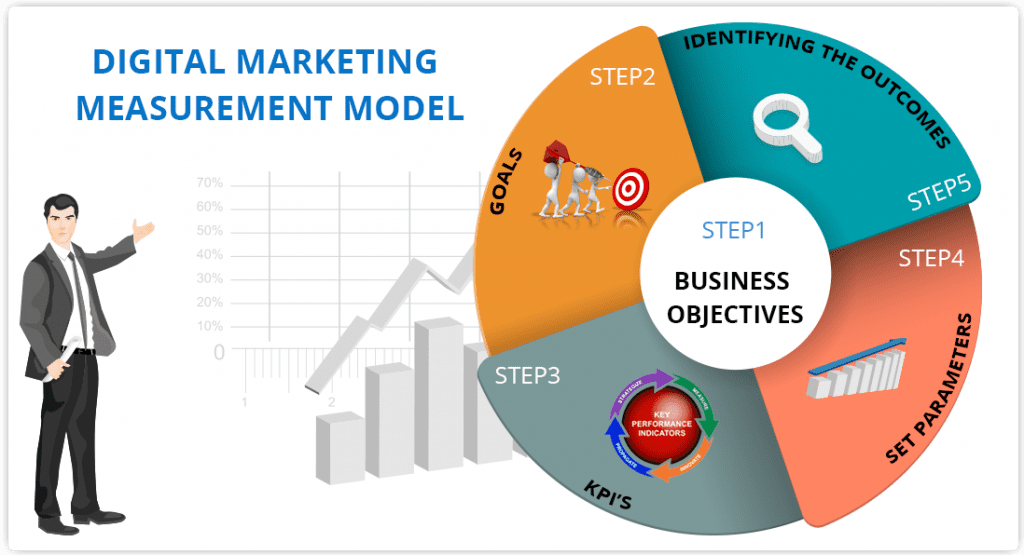
Marketing metrics and KPIs are the values that make it easy for the marketing team to decide the goals.
moreover analyse the performance based on those values.
Few key metrics that are universally accepted to judge your digital marketing success.
They can be put in three broad categories: (Traffic, conversion and revenue)
Do you want to master the essential disciplines in digital marketing? Check out the Digital Marketing Specialist course now!
Best Digital Marketing Metrics
The best KPIs for modern-day digital marketing is mostly data-driven
“ Marketing without data is like driving with your eyes closed”
– Dan Zarrella
# 1 Web traffic
Every site needs exposure with high quality targeted traffic to increase sales.
Web traffic is the amount of data sent and received by visitors to a website.
It is determined by the number of visitors and the number of pages they visit.
Sites monitor the incoming and outgoing traffic to analyze the popularity and trends
- Overall traffic: It is very important to monitor and also track regularly to have an estimate of how effectively your campaign is attracting traffic to your site.
Targeted and unique visitors: You cannot generate sales if your visitor leaves within ten seconds.
Key is to firstly research, secondly, identify and locate your target audience and market.
In order to take the desired action:Firstly subscribe to your site and secondly, buy what you are selling.
Tips for Generating high-quality unique visitor:
- Have quality web content
- On-page SEO optimization
- Promote to channels your visitors are active on
- Repurpose.repurpose.repurpose
#2 Traffic sources: Digital Marketing metrics not only that measure which sources are directing traffic to your website but also provides a comparison of those sources
.
Moreover, it is important to classify the traffic sources in order to analyze which source is over and underperforming.
These sources can be classified as:
Direct traffic- Those who type your URL into their browser.
Referral traffic: Visitors that visit your site by either by clicking on a URL or on another website.
#3 Organic traffic:– Google analytics separates the traffic that is driven to your site through search engine results from the traffic that arrives through referring channels.
Example: paid advertisement or another site that links to yours, this traffic is organic in nature.
Also, those who arrive at your site as a result of their search query by entering a keyword in the search engine and click on your listing.
Some useful tips for Organic search traffic and driving unique visitors to your site:
- Use keyword opportunity
- Keyword ranking
- Backlinking
- Link building
Campaign Traffic: Visitors that are drawn to your website through a dedicated campaign.
#4 Social media traffic:– Social media is a huge platform.
The traffic that is generated through social media also gives an insight into the effectiveness of your campaign.
Furthermore It is also a good indicator of your engagement and awareness.
# 5 Brand Awareness Metric:
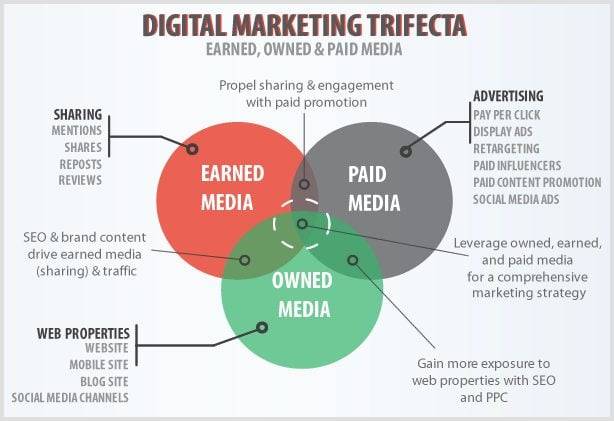
Brand awareness metric will help you analyse how your brand is performing not only on social but also as well as branded search.
It is designed to help digital marketers to gain control over online brand awareness with time.
Key tools of brand awareness metrics are:
Facebook posts and fans- Facebook is both, a major launchpad as well as front line tool for social media campaigns.
It helps you track the speed, efforts, and increase in the number of visitors or fans.
Twitter- Another crucial tool that helps you track your brand visibility.
Help understand trends and social behaviour.
Brand Mention- This provides an insight into how many times your brand has been mentioned on digital platforms like on blogs, social media, third party websites.
Social listening services like the Talkwalker can be used to calculate this unique digital marketing metric.
Branded Search- The number of people actually searching for your brand on search engines helps you analyse your brand awareness.
Branded search is compiled by tracking how many organic searches land on your site, brands homepage or product homepage.
Useful Practices To improve Brand Awareness
Develop relations with influencers in the digital marketing industry.
Since each social media platform is different, possibly for different content use different social media platforms.
Constantly engage, monitor , set up regular meetings, and go over your brand and campaign performance to analyze the metrics
Along with brand awareness metric, you must consider firstly, first visit metric, secondly, returning visit metric and lastly online conversion metric.
# 6 New Visitor vs Old Visitors:
If you are getting new visitors it reflects that your content is attractive.
The main concern is, Is it sticky enough to engage the visitor and attract frequent visits?
It is important to track this ratio week after week and month after month
Moreover, If the ratio of new visitors is more than in spite of driving traffic to your site your content does not meet their needs, hence you need to work on it.
# 7 Session:
The time duration that your visitor spends on your site can help you analyze your site.
How many pages the user visited
Any interaction on each page ( Comment or review)
# 8 Time On-Site: This is indicative of how interesting, engaging and interactive your content is.
More time the user spends on your site is likely to be a more committed customer.
Having monitored the frequently visited pages you can optimize your content.
# 9 Bounce Rate Digital marketing metric
This is another vital digital marketing metric that is specifically indicative of your site performance.
A visitor that leaves immediately after visiting your site, without performing any meaningful action contributes to bounce rate.
High bounce rate, therefore, indicates the flaws like the poor campaign, wrong target segment, Weak landing page, also irrelevant traffic source.
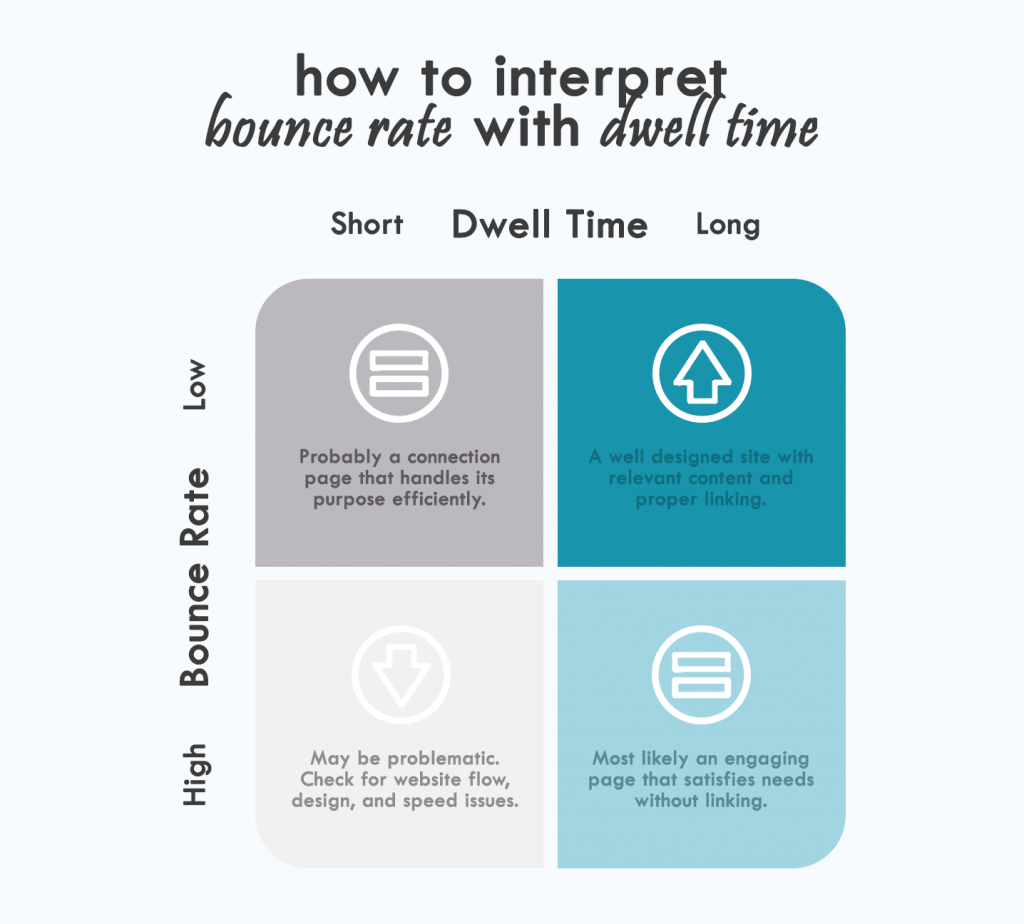
# 10 Conversion Rate Metric:
Simply put across conversion rate is a measurable action that progresses a potential customer towards becoming a paying customer
It is a very important digital marketing metric that can have a significant impact on your sites profitability.
If the conversion rate increases from 1% to 2% your profits double.
Conversion rate helps you analyze how successful you are in manipulating your traffic to perform the desired action.
Conversion rate is easy to calculate: organic or unique visitor/Conversions.
Few common types of conversion actions:
- If a visitor makes a purchase
- Submits a form( contact form,info form, lead generation form)
- Engaging through chat
- Subscribes or signs up
- Downloads some material or information
- Revisiting
- Upgrading their service
Using google analytics you can track your conversion rate.
The factor responsible for the conversion could vary from site to site.
Moreover you can be as broad and as specific with your conversion rate to examine your performance:
Overall conversion rate ( how well does your website convert traffic irrespective of the traffic source)
Marketing channel conversion rate (How many conversions are through google ads or facebook ads)
Page-level conversions (Which are the pages that are leading to maximum conversions)
Campaign conversion rate (how effective was your campaign or was there any specific campaign that worked better)
Individual conversion rate ( If an individual ad drives more traffic or you need to change a particular ad copy)
Keyword conversion rate ( using which keyword brings more traffic to your site or which keyword deserves more budget?)
# 11 Conversion by traffic source:
Conversion rate by traffic source metric is analyzed using the four different traffic source categories ( search, direct, referral and social)
# 12 Social Traffic And Conversions
This digital marketing metric helps you analyse the effectiveness of your social media campaigns in generating web traffic and goal conversions.
By calculating goal conversion rate(GCR) for each social media site you can understand the relevance and acceptability of your campaign.
Social media marketing needs to feed into the other areas of your sales and marketing efforts to provide a measurable ROI.
You need to monitor the total web traffic coming from each social media platform and how much is the conversion or goal result from each platform.
How to optimize your social media platforms with the help of high conversion keywords:
Facebook- Where,When, Tell Us, Inspire, Submit, Deals, Discount, Warns, Amuses
Twitter– Retweet, Follow, Social Media, New Blog Post, Check Out, Help, Top
Linkedin- Created, Improved, Increased, Developed, Reduced, Researched
Google + Share, Promote, Increase, Discover, Create.
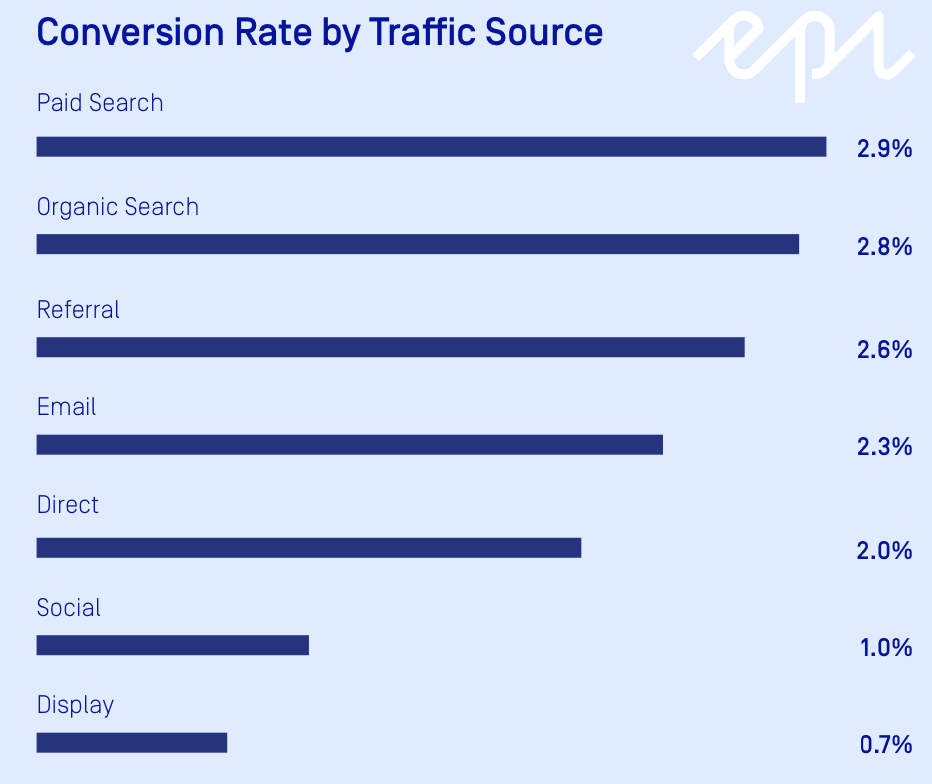
Now, this data exactly gives you an insight into the thought process you must employ while looking at your conversion rate by traffic source.
You can capitalize on your most valuable traffic source and change strategies for ineffective traffic source.
#13 Leads per month:
Monitoring the number of qualified leads, who have the potential to become a paying customer.
Such customers can be categorized into three groups
- Marketing qualified leads (MQL)- Leads evaluated and forwarded by the marketing team to the sales team.
- Sales accepted leads(SAL)- the sales team accepted the prospects and followed upon.
- Sales qualified leads(SQL)- Leads considered perspective by the sales team and are therefore moved further into the sales cycle.
# 14 Cost per lead: CPL shows the cost of acquiring a new lead.
It is important to evaluate all the effort, time resources spent to attract a lead
How to measure CPL: Add up the time, resources, cost, effort spent on a campaign
and compare it to the goal achieved.
How to improve your CPL: Create quality content on social media to get free website
traffic and new leads.
Analyse what types of free or paid campaigns work best and increase budget and
time.
# 15 Lead Conversion Rate metric:
This is one of the most important top- of- the- funnel conversion metrics.
Lead conversion rate is the percentage of visitors who are captured as leads.
It is a reflection of your ability to attract the right target audience.
Efficiency of your website turns them into leads.
For example if your website receives an average of 30,000 visitors per month and you manage to capture 1500 leads.
Lead conversion rate will be- 1500 leads / 30,000 visitors = 5%
Since you have a variety of visitors it is important to segment them into ( Cold, warm, hot).
Track the efficiency of your website to turn them into leads.
Website to Lead conversion rate is crucial to understand paid advertising spend and determining ROI.
It is easy to increase the number of leads generated by your site but more important is to increase the number of quality leads that actually turn into won business.
# 16 Click Through rate Digital marketing Metric:
This is one of the most important KPIs.
The click through rate is an indicator of how many people click on your link or your advertisement.
It is used to analyze the success of digital marketing campaigns.
It is used to measure how effective your digital marketing tools are.
High CTR is a reflection that your campaigns are targeted, effective, and useful for your target segment.
CTR is a ratio of number of clicks on a specific link or call to action ( CTA ) to the number of times people are exposed to that link, impressions.
CTR = ( Click throughs / impressions)X 100
It is evident that CTR is important to understand your customers, whether you are targeting the right segment or not.?
Whether you are meeting the needs of your audience or not?
Is your product or campaign convincing enough?
Useful tips to improve your Click through rate
- Optimize your headline and copy:Your headline must have one or two focus keywords.
Cater to the needs and emotions of your target audience.
Provide a solution to their needs.
- Include Call to action (CTA); Prompt your audience to take action.
Write direct, convincing and compelling cal to action and help your customer make decision.
- Use of visuals and images: Good visuals definitely boost your CTR.
Though it depends on the marketing channel, the choice of a suitable image is also important as some images work better than the others.
- Hashtags: Hashtags work across all social media and digital platforms.
They would increase your visibility through Facebook, Twitter, Linkedln, instagram.
Keeping this in mind research on popular hashtags that are trending and also relevant to your industry
# 17 Conversion rate tracking Metric:
Once the significance of conversion rate is established it is equally significant to track your conversion rate.
Tracking and using your conversion rate puts you on a relatively higher platform of online marketers, with a competitive advantage.
With tracking your conversion rate, you can optimize your campaigns and blow away your competition.
Some important advertising and analytics platforms that help you track your conversion rate-
- Google ads
- Google analytics
- Facebook and Instagram ads
- Twitter ads Pinterest promoted pins
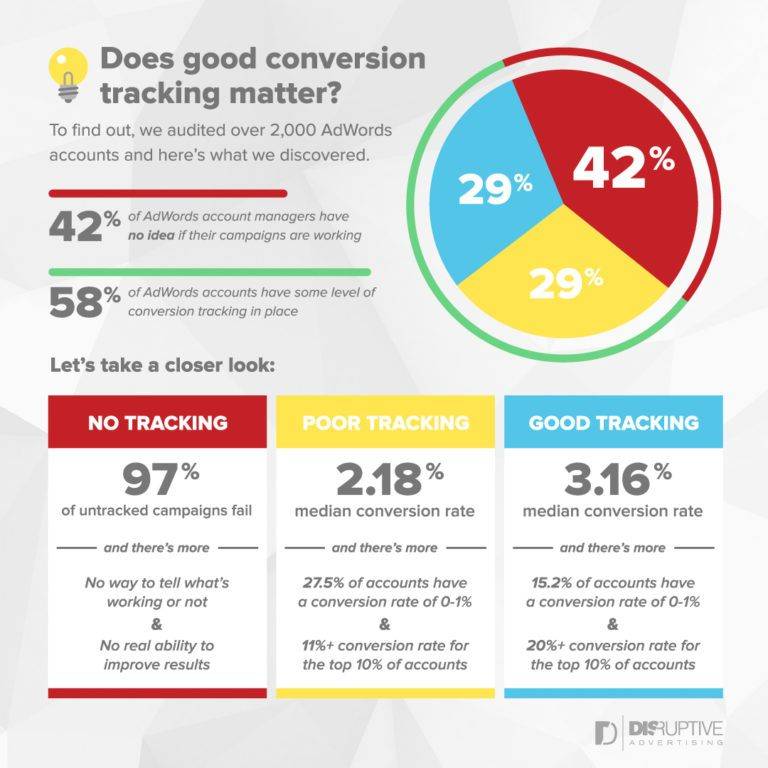
# 18 Conversion rate optimization (C R O):
Once you know your conversion rate and conversion rate tracking it is equally important to optimize your conversion rate.
CRO is the process of optimizing your landing page and website to extract maximum conversions from your potential traffic.
Without increasing your traffic, improving your conversion rate by 1% to 2% will double your conversions.
Useful tips to improve your CRO
Have a dedicated landing page- you must direct your traffic to a dedicated landing page if you are doing paid advertising like Google ads, Bing ads etc.
If you are paying to get traffic you might as well optimize your pages.
Elements that impact your conversion rate and profitability-
Headline: your headline has to be impactful and needs to sell hard
Offer: Your offer to the target audience has to be appealing, relevant and must resonate with your prospective clients.
Call to action: CTA is a very powerful digital marketing metric that propels the need, the urgency amongst the target audience to take immediate and desired action.
CTA is not an instruction but a polite request that not only provokes but also compels the visitor to take action.
Call now, register today, offer open, first fifty get fifty per cent off, first come first served, last chance, click to avail, just a click away, free trial.
These examples that leave the client not only thinking and creating a sense of need but also that triggers the desired call to action.
Graphics and Media: A new image , graphic or video is all it takes to refresh your campaign and attract visitors,engage them andconvert.
A/B Test: If you are serious about your CRO, all you have to do is set up two different variants of your page.
divert your traffic between the two.
You need a CRO software to split your traffic.
Google optimize: it is free but does not give you real-time results, therefore, may not be a good option for all
Unbounce: For testing landing pages
Its powerful, easy to use system allows you to create and test landing pages quickly.
Optimizely: Though it is expensive but has additional features that provide additional CRO insight.
Visual Website Optimizer: it is cheaper than optimizer and has an intuitive interface.
# 19 Cost per click or pay per click Digital Marketing Metric:
This is an advertising model to drive traffic to your website.
Price that you pay for every click in your pay per click campaign is the CPC.
Every click represents a visit, an interaction with your productor service.
This is the attention you are buying.
It is important to note what type of attention you are buying and how much it is costing you.
Your CPC must be less than or equal to your maximum bid
CPC is heavily influenced both by you and your competitor.
CPC formula
Competitor ad rank/your quality score+.01= Actual CPC Embed video
# 20 Cost per Conversion digital marketing metric:
This term is used in Web analytics and online advertising that indicates total cost paid for a campaign in relation to the goal success.
It is the ratio of number of viewers to the successful conversion- sign up, purchase, any fruitful interaction.
This metrics analyses how much it actually costs the advertizer to acquire a real customer.
There are traffic packages where the advertizer gets a specific number of views or time span for a fixed amount.
For instance if a $ 100 Campaign for 100 views results in 8 conversions then-
CPC= $100/8, so cost per conversion is $12.5
How to reduce cost per conversion:
- Pause low-converting keywords- Review your keywords regularly and analyse which keywords are not generating traffic or conversions
If a keyword has generated one conversion out of 1000 clicks it is worth pausing.
- Identify high-converting keywords- Use the “ SearchTerms” tab to learn how customers are finding your ads.
You will get a list of all the long-tail keywords,
Adding these keywords to your campaign will be a great opportunity to target users at a lower cost
- Add negative keywords- Negative keywords prevent you from targeting viewers who are not likely to be potential customers.
For instance if your ecommerce store is exclusively selling kids wear then choose to exclude users searching for women’s and men’s wear.
- Choose the best time to show your ads- Analyse what is the time when maximum conversions are likely to occur.
- Improve your landing page- your ad must direct the user to the landing page
( pages with information about your services or contact form) that is relevant to their search)
# 21 Cost per acquisition digital marketing metric:
This metric measures the aggregate cost to acquire one paying customer on a campaign.
It is a very important financial tool to directly measure the revenue impact of the campaign
CPA provides the business perspective to gauge the campaign success
It is used in the following paid marketing mediums:
- PPC
- Affiliate
- Display
- Social Media
- Content marketing
It can also be used for ecommerce SEO, email, and other platforms without direct advertising costs but still require overhead (labor,indirect expenses such as content production etc.)
# 22 Exit rate digital marketing metric:
Another vital metric that gives you an insight into why your potential client exits without making a meaningful action.
when the visitor exits the site at the last page it is a natural exit
When a visitor exits abruptly from any page that is an unnatural exit
Unlike bounce rate where the visitor leaves immediately after visiting your site, Exit rate is the percentage of visitors that leave your website from a particular page.
By doing so the exit rate also reflects the bounce rate
As per google analytics the formula to calculate exit rate is:
Single page exit rate = number of page exits/number of page views
Exit rate percentage gives an insight into-
- Is the page content having a direct impact on visitor conversion?
- From which page of the conversion path did the visitor leave?
- If the visitor is exiting from the key page then what is the reason?
- Does any particular channel or device trigger the exit?
- Are different visitors exiting from different pages?
# 24 Customer lifetime value digital marketing metric:
CLTV is the amount of gross profit that is given by a single customer over the entire time they do business with a company.
This Metric helps you monitor how much revenue every new customer is likely to bring throughout their lifetime.
CLTV helps you make decisions that help you retain, attract your most valuable customers.
Identifying your life time client and their needs you can continue to create, design and provide products and services that meet your clients requirements.
CLTV helps you
- new customer acquisition
b) Increase company profitability
c) retention of customers
# 25 Overall ROI:
This metric is the measure of overall profit or loss generated on your digital marketing campaign based on your total investment.
Analysing your ROI is the only way to understand whether you are allocating your budget effectively and also extracting the most out of your amount spent.
Important metrics that help you measure your ROI
- Conversion rate metrics
- Cost per lead
- Lead closed rate
- Cost per acquisition
- Average order value
- Customer lifetime value
Metrics that you use to measure ROI depends on your goals and objectives
Some metrics you can use to measure digital marketing ROI based on your tactics:
Email- Open rate, click through rate, bounce rate, unsubscribe rate, conversions, leads acquired.
Social Media– engagement rate, clicks, click through rate, conversions, leads acquired, fans, followers
Landing pages– traffic, unique visitors, returning visitors, total page views, time on site, actions, conversions
Blogs– Traffic, clicks, unique visitors, returning visitors, actions and conversions
SEO Digital marketing metrics:
Search engine optimization is used for growing quality and quantity of website traffic
It increases the visibility of your website
Organic traffic from search engines is one of the most profitable lead channels for digital marketers
SEO metrics focus only on organic traffic and acquiring highly targeted leads.
Using SEO tools like Moz,Alexa, or SEMrush to crawl the web and see all inbound links to your web
It shows the number of monthly website visits that come through search engine results from Google, Bing etc.
Organic search is most beneficial , free and generates targeted leads.
Retention rate metric-
This metric indicates the number of clients that continue using your product over a long period of time
They repeat their purchases.
You also get an insight into how well engaged your customers are.
You can also evaluate that your customer support or user experience is able to build and maintain customer loyalty.
How to calculate retention rate
Retention Rate = ((CE-CN)/CS))X100
CE is number of customer at the end of the period
CN is number of customer acquired during the period
CS is the Number of clients at the start of the period
Digital marketing metrics or KPIs are quantifiable goals that help you measure your success.
With the help of above mentioned digital marketing metrics you can set up your goals, expectations and prove that their work has a positive impact on your ventures.
I am sure with such deep insight into the digital marketing metrics , you will be able to optimize your campaigns, choose your target audience, drive maximum traffic to your website and have a maximum conversion rate.
Recommended Reads:
- Top 10 Best Digital Marketing Courses Institute in India
- Top 20 Digital Marketers in India
- Top 14 Best Digital Marketing Courses in Indore
- Top 23 Digital Marketing Courses in Mumbai
- Top 10 Best Content Writing Courses in India
- Top 12 Content Writing Courses in Delhi NCR
FAQs
Q What is an SEO?
Search engine optimization is a process to increase quality and quantity traffic.
Q What are Keywords?
Keywords are the words or phrases people use with search engines to find relevant
information.Keywords help optimize content for search.
Q what is pay per click (PPC)?
It is a metric to buy traffic. Marketers pay a fee each time their ad is clicked on.
Q which social media is more popular for digital marketing?
Social media is huge platform and mostly customers spend more time searching on
facebook,Instagram, Twitter,Linkedin, and Pinterest.
Q What is a call to action?
Once you have a visitor on your website, CTA is a prompt that creates a sense of urgency and prompts the visitor to take a desirable action.
For example- call now, buy now, register now.
apps-fileview.texmex_20230223.01_p1
schema code.txt
Displaying schema code.txt.


